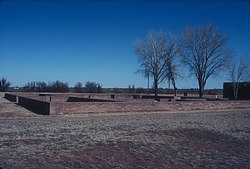Bosque Redondo
|
Fort Sumner Ruins
|
|

Fort Sumner
|
|
| Nearest city | Fort Sumner, New Mexico |
|---|---|
| Area | 50 acres (20 ha) |
| Built | 1862 |
| Architect | Alexander LaRue |
| NRHP Reference # | 74001194 |
| NMSRCP # | 139 |
| Significant dates | |
| Added to NRHP | August 13, 1974 |
| Designated NMHS | 1968 |
| Designated NMSRCP | January 9, 1970 |
Fort Sumner was a military fort in De Baca County in southeastern New Mexico charged with the internment of Navajo and Mescalero Apache populations from 1863-1868 at nearby Bosque Redondo.
On October 31, 1862, Congress authorized the construction of Fort Sumner. General James Henry Carleton initially justified the fort as offering protection to settlers in the Pecos River valley from the Mescalero Apache, Kiowa, and Comanche. He also created the Bosque Redondo reservation, a 1,600-square-mile (4,100 km2; 1,000,000-acre) area where over 9,000 Navajo and Mescalero Apaches were forced to live because of accusations that they were raiding white settlements near their respective homelands. The fort was named for General Edwin Vose Sumner.
The stated purpose of the reservation was for it to be self-sufficient, while teaching Mescalero Apache and Navajo how to be modern farmers. General Edward Canby, whom Carleton replaced, first suggested that the Navajo people be moved to a series of reservations and be taught new skills. Some in Washington, D.C. thought that the Navajo did not need to be moved and that a reservation should be created on their own land. Some New Mexico citizens encouraged killing the Navajo or at least removing them from their lands. The 1865 and 1866 corn production was sufficient, but in 1867 it was a total failure. Army officers and Indian Agents realized that Bosque Redondo was a failure, as it had poor water and too little firewood for the numbers of people who were living there. The Mescalero soon ran away; the Navajo stayed longer, but, in May 1868, were finally permitted to return to their native lands.
...
Wikipedia
